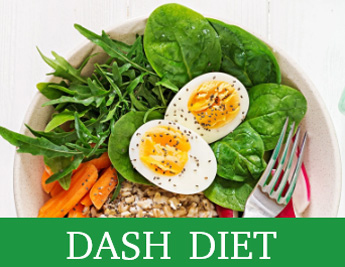What Is the DASH Diet?
DASH stands for “Dietary Approaches to Stop Hypertension.” As the name suggests, this eating plan was originally introduced to lower high blood pressure—a condition that impacts about 1 in 3 U.S. adults and greatly increases the risk of heart disease, stroke, and kidney disorders.
Since its launch, it has earned widespread support from health experts and recognition from organizations like the National Heart, Lung, and Blood Institute for its proven ability to promote cardiovascular health for people of all ages.

Basically, the DASH plan recommends incorporating heart-healthy choices into your everyday meals. It promotes a wide range of nutrient-rich foods that help maintain healthy blood pressure and support overall wellness. It is:
✅ Low in saturated fat and dietary cholesterol.
✅ Low in sodium—especially in the low-sodium version, which limits salt to 1,500 milligrams per day.
✅ Rich in potassium, magnesium, calcium, protein, and fiber—nutrients that naturally support healthy blood pressure.
✅ Focused on whole foods like fruits, vegetables, and low-fat dairy.
✅ Inclusive of whole grains, fish, poultry, and nuts.
✅ Restrictive of red meats, sweets, and sugary beverages.
Health Benefits of the DASH Diet
The primary aim of the DASH diet is to lower blood pressure. Studies show that people who follow DASH can start to lower their blood pressure in just a few weeks, often without medication.
However, the DASH diet’s benefits extend well beyond blood pressure control, It:
Supports a Healthy Weight
The DASH diet promotes whole, nutrient-rich foods while cutting back on processed, high-calorie items, making it easier to reach and maintain a healthy weight. Studies show that consistent adherence to DASH can lead to gradual weight loss.
Improves Cholesterol Levels
Since high cholesterol is a major contributor to heart disease, DASH’s emphasis on fiber-rich foods and healthy fats can be especially beneficial. This approach has been shown to lower LDL (“bad”) cholesterol and boost HDL (“good”) cholesterol, supporting overall heart health.
Reduces Risk of Chronic Diseases
Research links it to a lower risk of Type 2 diabetes, metabolic syndrome, and certain cancers, such as breast and colorectal cancer. Its combination of antioxidants, anti-inflammatory compounds, and nutrients that stabilize blood sugar plays a key role in these protective effects.
Foods to eat
The DASH diet focuses on eating heart-healthy foods that you can easily find in your grocery store:
-
Whole grains, like whole-grain bread, brown rice and quinoa.
-
Fat-free or low-fat dairy, like skim milk, low-fat cheese and low-fat yogurt.
-
Nuts, seeds and legumes, like almonds, spinachflaxseed and lentils.
-
Fats and oils, like avocado, olive oil and canola oil.
The DASH diet encourages to cut back on foods that can raise your blood pressure. These include:
-
Processed and packaged foods are often high in salt, even if they do not taste salty.
-
Fatty and processed red meats, like hot dogs, bologna, sausage and poultry with the skin on.
-
Full-fat dairy, like whole milk, cream and butter.
-
Oils that are solid at room temperature, like coconut and palm oils.
-
High-sugar foods, like candy, baked goods and desserts.
-
High-sugar drinks, like soda, juice and sweetened coffee or tea.
Overall, it emphasizes generous portions of fresh fruits and vegetables, complemented by lean proteins, low-fat dairy, beans, nuts, and wholesome vegetable oils. At the same time, it limits foods high in saturated fats, added sugars, and refined grains—a balance that naturally curbs excess calories and boosts the quality of nutrients in the diet.
In Summary
The DASH diet is not a quick fix but a balanced, long-term eating approach that supports both heart health and overall well-being. Whether you want to lower blood pressure, improve cholesterol, lose weight, or simply make better food choices, DASH offers a flexible, research-backed plan that can be tailored to your preferences and lifestyle. Over time, these small, consistent changes can lead to lasting improvements in cardiovascular health and quality of life.
Sticking to the plan becomes easier when you focus on making healthier choices each day. By incorporating heart-friendly foods into your routine and taking advantage of DASH’s adaptability, you can create a way of eating that works for you—and one you can maintain for the long run.
Medical Disclaimer.
Read further on:
≺≺ What is the Okinawan diet? What is the secret behind Okinawan long life expectancy?
≺≺ What are the four enemies of blood sugar?
≺≺ EWG’s- The Clean Fifteen: Fruits and Vegetables with the Lowest Pesticide Levels.
≺≺ What are antioxidants? How antioxidants in the fruits and vegetables help in preventing cancers and diseases?
≺≺ What foods should people with high blood pressure avoid?
≺≺ How can I reduce the risk of cancer-causing chemicals when cooking or grilling meat?
≺≺ How toxic are the nitrites used in curing processed meats?
≺≺ What are the worst meats for accumulating cancer-causing chemicals during cooking?
≺≺ How are artificial sweeteners made?
≺≺ Can Physical Activity Help Improve My Arthritis?
≺≺ How common is thumb pain from too much texting?
≺≺ What health problems are linked to consuming corn syrup?
≺≺ What happens to my blood vessels when I gain weight?
≺≺ What type of exercise is best for lowering my blood sugar?
≺≺ What impact can sitting for long periods have on my health?
≺≺ Does my social circle impact my weight?
≺≺ How toxic are the nitrites used in curing processed meats?
≺≺ What foods can lower prostate cancer risk?
≻≻ Watch this page for more such informative articles on Health, Nutrition, and Wellness.
≻≻-Back to Home page.
Further reading (External Links opens in new window):
≺≺- The Johns Hopkins Patient Guide to Diabetes- All About the Keto Diet.
≺≺- News Medical.Net- Best and Worst Foods to Eat on the Ketogenic Diet.
≺≺- Harvard Health Publishing- Should you try the keto diet?.
≺≺- Stanford Medicine- Pilot study shows ketogenic diet improves severe mental illness.

